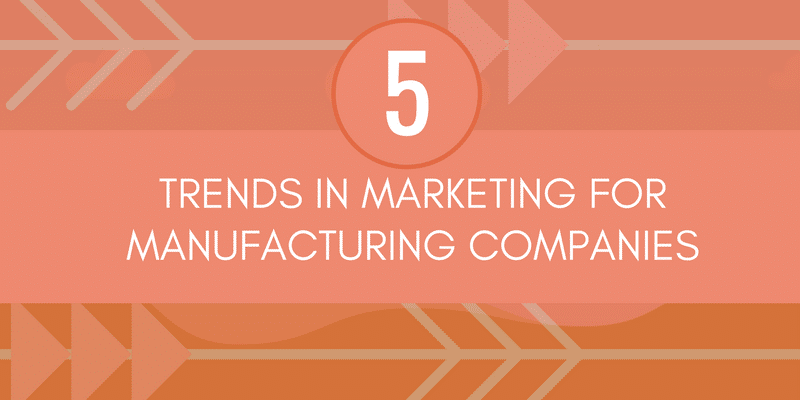Marketing for manufacturing is changing. What worked well a few years ago isn’t so bright and shiny anymore. It’s not that blogs, white papers, and social media have stopped working.
What’s changed is that these tactics aren’t novel anymore. After all, what’s special about having a blog and a Twitter handle these days? Even the smallest machine shop can create a Facebook page or an Instagram account.
Maybe you’ll get lucky and create a YouTube video that goes viral. That’s a great way to get Web traffic, but the odds are good that you won’t produce the next series of Will It Blend? videos. To win at marketing in 2018, smart manufacturers are betting on five trends.
- Longer blog entries
- More frequent blogging
- Words for leads
- Automated emails
- Increased outsourcing
Let’s take a closer look at each – and how you can compete and win.
Longer Blog Entries
Having a blog just isn’t a big deal anymore. What makes you stand out is the quality and value of the content that you produce. Size matters, too.
According to Curata, longer-form blog posts generate nine times more leads than shorter-form blog posts. Yet only 18% of the companies in the study were blasting out blog posts with 750 words or more. This reticence is your opportunity.
Another in-depth study by Moz and BuzzSumo found that long-form content consistently gets more shares and links than short-form content.
Long-form content consistently gets more shares and links than short-form content.Click To TweetIf paying for 750-word posts seems like a gamble, don’t raise the stakes so high. In general, blog content with 600 words hits the “sweet spot” for search engine optimization (SEO).
That’s right. SEO success isn’t about gaming Google with high-value keywords. It hasn’t been in years. To win with SEO and lead generation (more about that later), you’ll need to produce better, longer written content.
More Frequent Blogging
Posting infrequently is like planting a garden, hoping for some sunshine, and then watering your plants every now and then. Maybe you’ll get lucky and have a summer with just the right amount of sun and rain.
The chances are good, however, that “Garden of Eden” isn’t your location. If you want to get results, you’re going to have to roll up your sleeves and get dirty regularly.
According to the LinkedIn Marketing Community, less than 40% of marketers publish content weekly. If farmers watered their fields like this, your dinner would wither and die.
Seen another way, blogging on a weekly basis is a great way to stand out from the crowd. If you’re skeptical that you could find enough to write about, look at Elasto Proxy and Brush Research Manufacturing. They don’t miss a week.
Words for Leads
Visual marketing is powerful, but what’s the best way to generate leads?
According to DemandGen’s 2017 Content Preferences Survey Report, buyers are more willing to share personal information in exchange for written content such as white papers (76%), e-books (63%), and case studies (57%) than for visual media such as infographics (19%) or video (19%). Keep that in mind if you’re collecting email addresses.
There’s value in infographics and video, of course, but visual media is more about brand awareness and concise explanations than lead generation. The same is true of social media marketing, a powerful way to build your brand while boosting SEO.
It’s important to attach attractive images to your social media communications, but manufacturers who win link their posts to attractive offers of written content.
Automated Emails
What’s the most popular channel for sharing content? DemandGen’s 2017 Content Preferences Survey Report notes that 94% of respondents named email as their number one channel.
That’s about as close to 100% as you can get without giving away free money in exchange for a bunch of people to say “yes.” Amazingly, however, some manufacturers (even those with blogs) still don’t send regular emails.
Email tools like MailChimp and Constant Contact aren’t really automated, but they’re a good place to start. They also cost a whole lot less than HubSpot, Act-On, and all the rest.
If marketing automation is so wonderful, however, why do so many manufacturers fail to create automated emails through mechanisms such as HubSpot workflows? Why do emails that get triggered in Act-On “trigger” adverse reactions?
Manufacturers who pay big bucks for HubSpot, Act-On, and the like will start looking for a greater return on investment (ROI) in 2018. They’ll find a way to create workflows, even if it means ignoring some of the advice they’re getting from high-priced consultants about sales funnels.
They’ll also realize that getting an occasional complaint about an email is like talking to a cranky engineer. It happens – and you move on.
Increased Outsourcing
Longer content. More frequent blogging. Words for leads. Automated email. If you’re wondering where you’ll find the time in 2018, you’re not alone. If you’re wondering where you’ll find the budget, consider the following facts from the Content Marketing Institute.
Content marketing, a marketing strategy that covers all the tactics you’ve been reading about in this article, costs 62% less than traditional marketing while yielding eight times more website traffic and three times as many leads.
Content marketing, costs 62% less than traditional marketing and yields three times as many leads.Click To TweetSimply put, a manufacturing business that plans to build and grow can’t ignore numbers like this. At the same time, industrial companies are sensitive to increasing head counts. Insurance premiums are rising and what if a new hire doesn’t work out?
There are plenty of content marketers you can hire, of course, but would they rather write about food or sports than manufacturing – your very livelihood?
What’s Next?
Now that you know about the five key trends in marketing for manufacturing, it’s time to ask yourself some hard questions about how to get all this work done.
- What is the specific work that you want to accomplish?
- What is the scope and frequency of these marketing activities?
- Do you have an in-house resource that can do the work?
- What is the cost to do this work in-house?
- What is the cost of outsourcing?
For help answering these questions and planning a winning marketing strategy for 2018 and beyond, request a free consultation.
Steve Melito is an award-winning writer and editor specializing in manufacturing, material science, and homeland security. He is the founder and owner of Thunderbolt Business Services, a digital marketing and content development firm with clients and partners in New York, Montreal, Los Angeles, and New Delhi.




